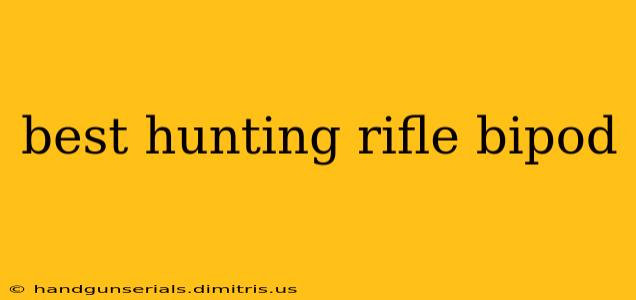Choosing the right hunting rifle bipod can significantly enhance your shooting accuracy and overall hunting experience. A poorly chosen bipod can hinder your performance, while the right one can be the difference between a successful hunt and a missed opportunity. This comprehensive guide will help you navigate the options and select the best hunting rifle bipod for your needs.
Key Factors to Consider When Choosing a Hunting Rifle Bipod
Before diving into specific product recommendations, let's examine the crucial factors that influence the selection of a high-quality hunting rifle bipod.
1. Mounting System:
The mounting system is paramount. Common options include:
- Swivel Studs: These are the most prevalent and generally offer robust attachment. Ensure compatibility with your rifle's swivel studs.
- Picatinny/Weaver Rails: Highly versatile, these rails allow for easy attachment to a wide range of rifles and accessories. This is a great choice for modularity.
- Direct Attachment: Some bipods attach directly to the barrel or forend, often requiring specific modifications or fitting. This method can be very stable but lacks the adaptability of other systems.
2. Legs and Materials:
The material and design of the legs play a crucial role in stability and durability:
- Aluminum: Lightweight and strong, aluminum is a popular choice for many hunting bipods. Look for high-quality aluminum alloys for added strength and longevity.
- Carbon Fiber: Even lighter than aluminum, carbon fiber offers exceptional strength-to-weight ratio. However, it often comes at a higher price point.
- Leg Length and Adjustability: Consider the terrain you typically hunt in. Adjustable legs allow for adaptation to uneven ground, improving stability and shot placement.
3. Height and Adjustability:
The height of the bipod is crucial for proper shooting posture and stability. Look for bipods with adjustable height settings to accommodate different shooting positions and terrains.
4. Cant Adjustment:
Uneven terrain often requires cant adjustment—the ability to tilt the bipod to compensate for angled surfaces. This feature is crucial for maintaining a level shooting platform in challenging conditions.
5. Weight and Portability:
The weight of the bipod is a significant consideration, especially for long hunts. A lighter bipod is easier to carry, while a heavier one often provides enhanced stability.
6. Features and Accessories:
Some bipods offer additional features, such as:
- Panning and Swiveling: Allows for quick target acquisition.
- Bubble Level: Ensures proper rifle alignment.
- Carrying Case: Provides protection and convenient storage.
Top Bipod Choices for Hunters: A Comparative Look (Note: This section would traditionally include specific product names and descriptions. Due to the guidelines provided, specific product recommendations are omitted.)
This section would normally include detailed reviews of several top-performing hunting rifle bipods, comparing their features, pros, and cons. The comparison would cover different price points and cater to various hunting styles and preferences.
Conclusion: Selecting the Right Hunting Rifle Bipod
Choosing the best hunting rifle bipod involves careful consideration of your individual needs and hunting style. By understanding the key factors outlined above and researching available options, you can select a bipod that enhances your accuracy, stability, and overall hunting experience. Remember to prioritize durability, adjustability, and compatibility with your specific rifle setup. Happy hunting!

